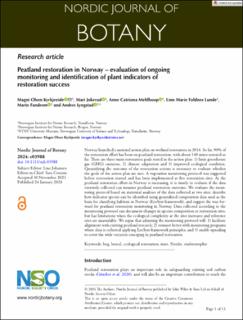| dc.contributor.author | Kyrkjeeide, Magni Olsen | |
| dc.contributor.author | Jokerud, Mari | |
| dc.contributor.author | Mehlhoop, Anne Catriona | |
| dc.contributor.author | Lunde, Linn Marie Foldnes | |
| dc.contributor.author | Fandrem, Marte | |
| dc.contributor.author | Lyngstad, Anders | |
| dc.date.accessioned | 2024-01-25T14:41:56Z | |
| dc.date.available | 2024-01-25T14:41:56Z | |
| dc.date.created | 2024-01-24T09:37:34Z | |
| dc.date.issued | 2024 | |
| dc.identifier.issn | 0107-055X | |
| dc.identifier.uri | https://hdl.handle.net/11250/3113928 | |
| dc.description.abstract | Norway launched a national action plan on wetland restoration in 2016. So far, 90% of the restoration effort has been on peatland restoration, with about 140 mires restored so far. There are three main restoration goals stated in the action plan: 1) limit greenhouse gas (GHG) emission, 2) climate adaptation and 3) improved ecological condition. Quantifying the outcome of the restoration actions is necessary to evaluate whether the goals of the action plan are met. A vegetation monitoring protocol was suggested before restoration started and has been implemented at five restoration sites. As the peatland restoration effort in Norway is increasing, it is timely to evaluate if the data currently collected can measure peatland restoration outcome. We evaluate the moni-toring protocol based on statistical analyses of the data collected at two sites, describe how indicator species can be identified using generalized composition data used as the basis for classifying habitats in Norway (EcoSyst framework), and suggest the way for-ward for peatland restoration monitoring in Norway. Data collected according to the monitoring protocol can document changes in species composition at restoration sites, but has limitations when the ecological complexity at the sites increases and reference sites are unavailable. We argue that adjusting the monitoring protocol will: 1) facilitate alignment with existing peatland research; 2) connect better with monitoring programs where data is collected applying EcoSyst framework principles; and 3) enable upscaling to cover the wide variation emerging in peatland restoration. bog, boreal, ecological restoration, mire, Nordic, ombrotrophic | en_US |
| dc.language.iso | eng | en_US |
| dc.publisher | Wiley | en_US |
| dc.rights | Navngivelse 4.0 Internasjonal | * |
| dc.rights.uri | http://creativecommons.org/licenses/by/4.0/deed.no | * |
| dc.title | Peatland restoration in Norway – evaluation of ongoing monitoring and identification of plant indicators of restoration success | en_US |
| dc.title.alternative | Peatland restoration in Norway – evaluation of ongoing monitoring and identification of plant indicators of restoration success | en_US |
| dc.type | Peer reviewed | en_US |
| dc.type | Journal article | en_US |
| dc.description.version | publishedVersion | en_US |
| dc.subject.nsi | VDP::Zoologiske og botaniske fag: 480 | en_US |
| dc.subject.nsi | VDP::Zoology and botany: 480 | en_US |
| dc.source.journal | Nordic Journal of Botany (NJB) | en_US |
| dc.identifier.doi | 10.1111/njb.03988 | |
| dc.identifier.cristin | 2233417 | |
| dc.relation.project | Andre: Norwegian Environment Agency | en_US |
| cristin.ispublished | true | |
| cristin.fulltext | original | |
| cristin.qualitycode | 1 | |

